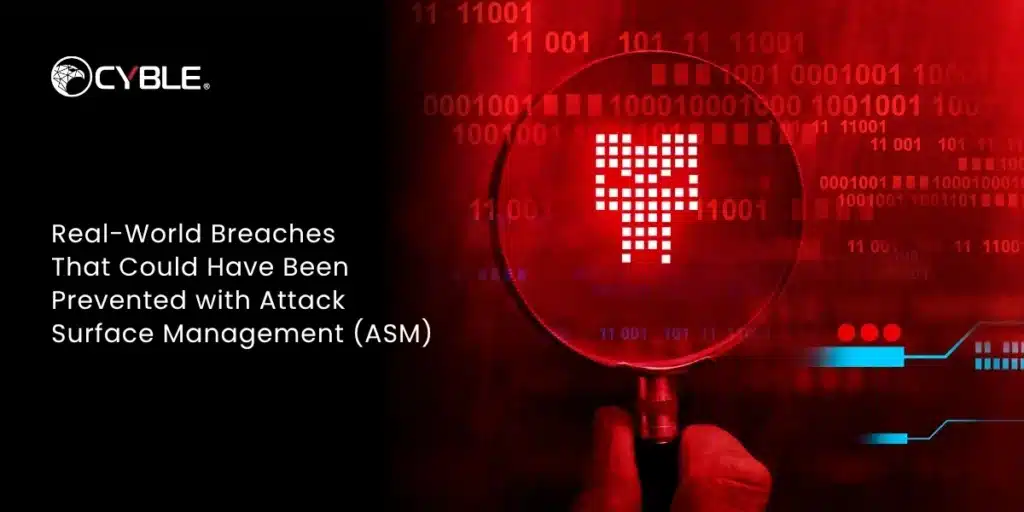Real-World Breaches That Could Have Been Prevented with Attack Surface Management (ASM)

Organizations throughout the world are living in a constant fear of cyber threats. The remote working methods and the adoption of cloud technologies have further fueled this fear. Each new integration, whether it’s a third-party vendor, an unmanaged endpoint, or a forgotten subdomain, adds to an organization’s attack surface. Without full visibility into these expanding networks and without leveraging threat intelligence products, vulnerabilities remain hidden in plain sight
Attack surface management (ASM) has become the foundation of modern cybersecurity. Unlike traditional perimeter defenses, ASM continuously identifies, monitors, and secures every exposed digital asset, offering a real-time map of potential risks.
From Visibility to Prevention
The principle behind attack surface management is straightforward: an organization cannot protect what it cannot see. By 2025, ASM has evolved into an ecosystem of attack surface protection solutions that work alongside endpoint security solutions, threat intelligence products, and third-party cybersecurity solutions. Together, these technologies deliver complete visibility across digital environments, on-premises, in the cloud, and across interconnected supply chains.
A key advantage of modern ASM platforms is their integration with AI and machine learning. These tools analyze massive volumes of network and system data to detect misconfigurations, weak credentials, and anomalies in real time. When paired with a CSMP tool (Cybersecurity Surface Management Platform), organizations gain automated discovery, risk prioritization, and rapid remediation capabilities, all critical for reducing exposure.
Breaches That Could Have Been Avoided
The last few years have shown how the absence of attack surface management can lead to major data compromises. Many of these incidents share a common root cause: lack of continuous visibility.
In one high-profile case, a global marketing firm suffered a data leak after an unsecured cloud database was left exposed to the public internet. The breach compromised millions of customer records. With continuous ASM monitoring, the misconfigured storage instance could have been detected and secured before the data was accessed.
Another example involves a healthcare provider targeted through an unpatched IoT device. The outdated firmware provided an easy entry point for ransomware attackers. A comprehensive attack surface management solution, designed to monitor IoT and operational technology environments, would have identified the vulnerable endpoint and triggered a timely alert.
Supply chain breaches have also stressed the importance of third-party cybersecurity solutions. In one 2024 incident, a software vendor’s compromised update mechanism enabled attackers to infiltrate multiple downstream clients. Organizations equipped with ASM integrated into threat intelligence products quickly detected the malicious component, isolating affected systems before the malware could propagate.
Integration with Zero Trust and Endpoint Security
Modern cybersecurity frameworks increasingly rely on Zero Trust Architecture (ZTA)—a model that enforces verification at every access point. When integrated with ASM and endpoint security solutions, organizations gain a closed feedback loop that ensures any change in the digital environment triggers immediate validation. If an unauthorized device, misconfigured cloud resource, or outdated certificate appears, ASM detects it, and endpoint protection enforces remediation policies.
This constant validation eliminates blind spots and ensures security controls evolve alongside the organization’s dynamic digital infrastructure.
The Role of Threat Intelligence and Continuous Monitoring
A defining feature of today’s ASM ecosystem is its close relationship with threat intelligence products. Real-time threat feeds enrich ASM data, giving analysts context around vulnerabilities and cybersecurity risks. This intelligence-driven approach enables teams to prioritize remediation based on actual threat relevance rather than theoretical severity.
Additionally, the integration of CSMP tools allows organizations to automate workflows, scanning new assets, ranking vulnerabilities, and implementing security patches within minutes. This level of automation is crucial in large enterprises where thousands of digital assets may change daily.
Continuous discovery, real-time analytics, and predictive modeling together form the backbone of attack surface protection solutions, ensuring organizations stay protected from cyber threats rather than reacting after an incident occurs.
Third-Party Risk and the Supply Chain Factor
Modern organizations operate within complex digital ecosystems where security depends on every connected partner. Vendors, suppliers, and service providers can introduce vulnerabilities that go unnoticed without continuous oversight. Integrating third-party cybersecurity solutions into an attack surface management (ASM) framework enables ongoing assessment of vendor exposure, monitoring of shared assets, and detection of breach indicators across extended networks.
Recent breaches confirm a clear fact: prevention begins with visibility. Combining attack surface management, endpoint security solutions, CSMP tools, and threat intelligence products allows organizations to identify risks early and respond effectively. This proactive model replaces reactive security, ensuring all assets, internal, external, and cloud-based, remain protected.
Cyble supports this approach through its advanced attack surface management and threat intelligence capabilities, providing continuous monitoring, asset discovery, and risk reduction.

How Reliable Data Extraction Improves BizBuySell Market Evaluation

Building Strong Data Protection Habits for Ontario Businesses

3 Proven Ways to Improve Employee Productivity at Your Business

Accelerating drug discovery through the DEL-ML-CS approach

AI in Marketing Is No Longer a Buzzword — It’s the Strategy

How to Build, Customize, and Tune Your Own 50cc Mini Chopper for a Unique Look and Better Performance

Real-World Breaches That Could Have Been Prevented with Attack Surface Management (ASM)

White Dots on iPad Screen Understanding the Causes and Fixes








